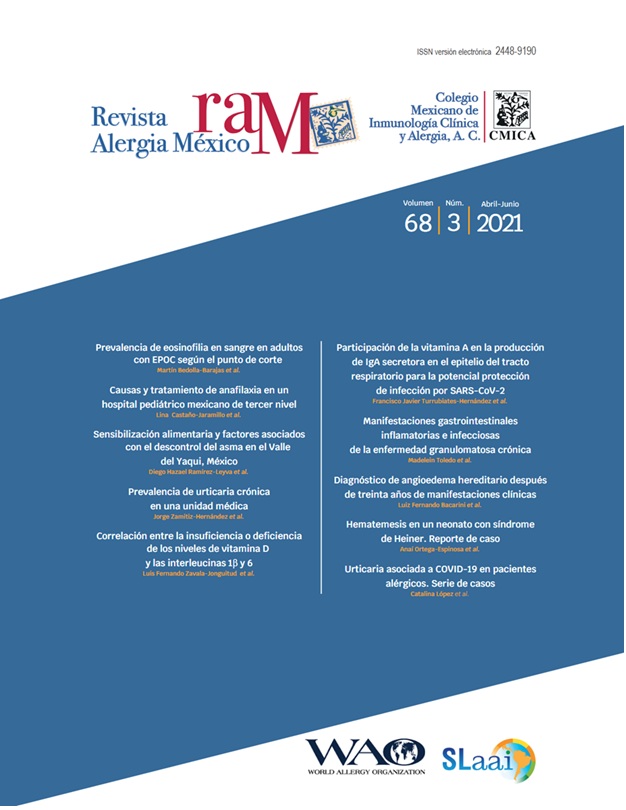Abstract
Objective: To determine the prevalence of blood eosinophilia in adults with chronic obstructive pulmonary disease (COPD) according to different cut-off points.
Methods: A cross-sectional study was carried out in patients with COPD. The frequency of blood eosinophilia was determined by absolute (cells/ µL) and relative (%) eosinophil count. Multivariate methods were used in order to identify the associated factors.
Results: 81 patients were included; the mean age was 71.9 ± 9.8 years; 46 (57%) of the patients were men. The prevalence of eosinophilia for the cut-off points of ≥ 100, ≥ 150, ≥ 200, ≥ 300, and ≥ 400 cells/µL was of 64.2%, 37.0%, 16.1%, and 9.9% respectively. Out of 81 patients, 34 (42%) had a relative eosinophil concentration of ≥ 2%; 21 (25.9%) ≥ 3%; 14 patients (17.3%) had ≥ 4%; and 10 patients (12.3%) had ≥ 5%. Eosinophilia of ≥ 100 cells/µL was associated with age of ≥ 80 years (OR = 6.04, p = 0.026), and with the exacerbation of COPD (OR = 9.40, p = 0.038); in contrast, eosinophilia of ≥ 2% was associated only with age of ≥ 80 years (OR = 3.73, p = 0.020). In addition, the eosinophil count of ≥ 100 and < 300 cells/µL was associated with the exacerbation of COPD (OR = 11.00, p = 0.026).
Conclusions: Our results suggest that the frequency of eosinophilia in the context of COPD shows substantial variations according to the used definition.
References
Biener AI, Decker SL, Rohde F. Prevalence and treatment of chronic obstructive pulmonary disease (COPD) in the United States. JAMA. 2019;322(7):602. DOI: 10.1001/jama.2019.10241
Perez-Padilla R, Menezes AMB. Chronic obstructive pulmonary disease in Latin America. Ann Glob Health. 2019;85(1):7. DOI: 10.5334/aogh.2418
Global strategy for the diagnosis, management, and prevention of chronic obstructive pulmonary disease. 2020 report [Internet]. Global Initiative for Chronic Obstructive Lung Disease; 2020.
Greulich T, Tüffers J, Mager S, Eder A, Maxheim M, Alter O, et al. High eosinophil blood counts are associated with a shorter length of hospital stay in exacerbated COPD patients - a retrospective analysis. Respir Res. 2020;21(1):106. DOI: 10.1186/s12931-020-01365-5
Oh YM, Lee KS, Hong Y, Hwang SC, Kim JY, Kim DK, et al. Blood eosinophil count as a prognostic biomarker in COPD. IntJ Chron Obstruct Pulmon Dis. 2018;13:3589‐3596. DOI: 10.2147/COPD.S179734
Shin SH, Park HY, Kang D, Cho J, Kwon SO, Park JH, et al. Serial blood eosinophils and clinical outcome in patients with chronic obstructive pulmonary disease. Respir Res. 2018;19(1):134. DOI: 10.1186/s12931-018-0840-x
Ho J, He W, Chan MTV, Tse G, Liu T, Wong SH, et al. Eosinophilia and clinical outcome of chronic obstructive pulmonary disease: a meta-analysis. Sci Rep. 2017;7:13451. DOI:10.1038/s41598-017-13745-x
Yun JH, Lamb A, Chase R, Singh D, Parker MM, Safaerli A, et al. Blood eosinophil count thresholds and exacerbations in patients with chronic obstructive pulmonary disease. J Allergy Clin Immunol. 2018;141(6):2037-2047. DOI: 10.1016/j.jaci.2018.04.010
Miller MR, Hankison J, Brusasco V, Burgos F, Casaburi R, Coates A, et al. Standarisation of spirometry. Eur Respir J. 2005;26(2):319-338. DOI: 10.1183/09031936.05.00034805
Plaza V, Álvarez F, Calle M, Casanova C, Cosío BG, López-Viña A, et al. Consensus on the Asthma-COPD Overlap Syndrome (ACOS) between the Spanish COPD Guidelines (GesEPOC) and the Spanish Guidelines on the Management of Asthma (GEMA). Arch Bronconeumol. 2017;53(8):443-449. DOI: 10.1016/j.arbres.2017.04.002
van Kampen V, de Blay F, Folletti I, Kobierski P, Moscato G, Olivieri M, et al. EAACI position paper: skin prick testing in the diagnosis of occupational type I allergies. Allergy. 2013;68(5):580-584. DOI: 10.1111/all.12120
Brożek JL, Bousquet J, Agache I, Agarwal A, Bachert C, Bosnic-Anticevich S, et al. Allergic Rhinitis and its Impact on Asthma (ARIA) guidelines-2016 revision. J Allergy Clin Immunol. 2017;140:950-958. DOI: 10.1016/j.jaci.2017.03.050
Mahler DA, Weels CK. Evaluation of clinical methods for rating dyspnea. Chest. 1988;93:580-586. DOI: 10.1378/chest.93.3.580
Soler-Cataluña JJ, Martínez-García MA, Sánchez-Sánchez L, Tordera-Perpiñá M, Román-Sánchez P. Severe exacerbations and BODE index: two independent risk factors for death in male COPD patients. Respir Med. 2009;103:692-699. DOI: 10.1016/j.rmed.2008.12.005
Caspard H, Ambrose CS, Tran TN, Chipps BE, Zeiger RS. Associations between individual characteristics and blood eosinophil counts in adults with asthma or COPD. J Allergy Clin Immunol Pract. 2020;5(8):1606-1613. DOI: 10.1016/j.jaip.2019.12.019
Wu HX, Zhuo KQ, Cheng DY. Prevalence and baseline clinical characteristics of eosinophilic chronic obstructive pulmonary disease: a meta-analysis and systematic review. Front Med (Lausanne). 2019;6:282. DOI: 10.3389/fmed.2019.00282
Vedel-Krogh S, Nielsen SF, Lange P, Vestbo J, Nordestgaard BG. Blood eosinophils and exacerbations in chronic obstructive pulmonary disease. The Copenhagen general population study. Am J Respir Crit Care Med. 2016;193(9):965-974. DOI: 10.1164/rccm.201509-1869OC
DiSantostefano RL, Hinds D, Le HV, Barnes NC. Relationship between blood eosinophils and clinical characteristics in a cross-sectional study of a US population-based COPD cohort. Respir Med. 2016;112:88-96. DOI: 10.1016/j.rmed.2016.01.013
Hartl S, Breyer MK, Burghuber OC, Ofenheimer A, Schrott A, Urban MH, et al. Blood eosinophil count in the general population: typical values and potential confounders. Eur Respir J. 2020;55(5):1901874. DOI: 10.1183/13993003.01874-2019
Martínez-Barbabosa I, Gutiérrez-Quiroz M, Ruiz-González L, Romero-Cabello R, Ortiz-Pérez H, Pimienta-Lastra R, et al. Prevalencia de microorganismos intestinales parásitos y comensales en adultos mayores en la Alcaldía Iztapalapa, Ciudad de México. Rev Mex Patol Clin Med Lab 2018;65(4):200-205.

This work is licensed under a Creative Commons Attribution-NonCommercial 4.0 International License.
Copyright (c) 2021 Revista Alergia México





